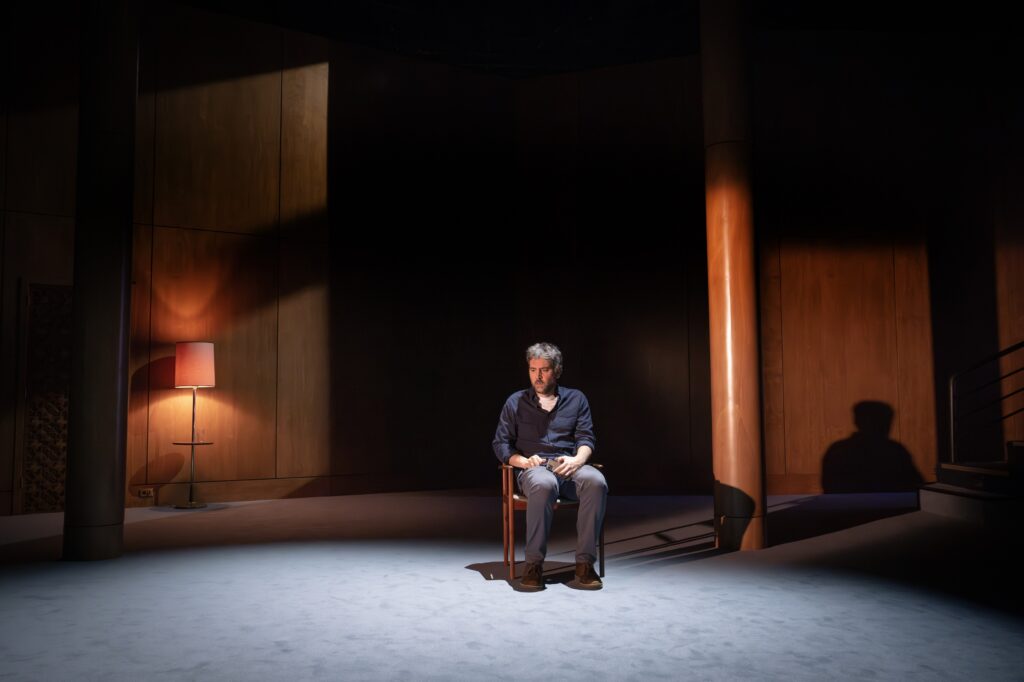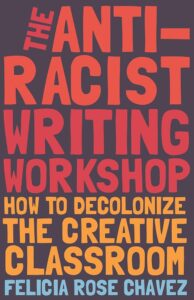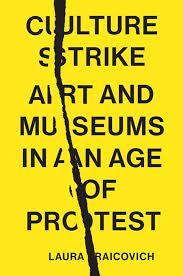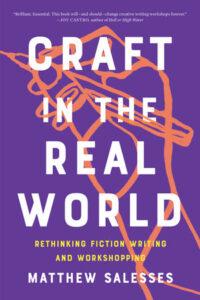This essay was first published last month in our subscriber-only newsletter. To receive the monthly newsletter and to support Full Stop’s original literary criticism, please consider joining us on Patreon.

My friend has been a professor for thirty years and never felt the need to identify her ethnicity until this past fall. “I’m not really a Jew,” she says to me, which of course is a provocative thing to say, and I believe she intends to provoke. “But I’m a Jew now,” she says, referring to her on-campus activism organizing Jewish professors and administrators for a ceasefire in Gaza.
I’m not telling you her name because we don’t really know yet, as educators, if we’re doing the right thing. “No,” my friend says, “we know what we’re doing is right. It’s only our administrators who aren’t sure.”
It’s possible that though said administrators are sure of what they think, they are not sure what they should say or do in the incendiary context of today’s universities, rife with fear, real political censorship, and firings related to misguided accusations of antisemitism. What we think, what we say, and what we do are streams we may seek to keep separate to protect ourselves from public critique and misunderstanding.
We may also seek to keep these separate because we truly do not know what we think—because we are in constant process of reformulating our position based on a learning process as information shifts daily and propaganda roams the plains of social media. I try to position myself in this space of learning, an undertaking that is theoretically in line with the process of being an educator, but an uneasy position for an academic in the world of firm political stances.
In The Ally, Itamar Moses’s new play directed by Lila Neugebauer at The Public, our main character, Asaf, arguably doesn’t know what he thinks, what he has to say, nor what he should do. He is a rather hapless playwright, recently moved a university town where he is a part-time professor, seemingly employed at the university as a spousal hire when his wife, Gwen, takes a job as the university’s “Administrator for Community Relations and External Affairs,” a role intended to smooth things over between town and gown amidst a university real estate expansion process.
Even before Asaf becomes embroiled in campus politics, he is already highly implicated by his wife’s position. He doesn’t understand himself as such (or understand much at all about the local politics of the town or the university). “When I’m here I don’t get out much or . . . talk to anyone,” he says. But when a student, Baron, comes to Asaf asking him to sign a manifesto in protest of a recent racist police murder, Asaf is moved (seemingly for the first time) to care and to act like he cares. He’s a white Jew of Israeli American descent who doesn’t seem to feel personally involved or hailed by these issues.
The play frustrated me in many ways, many of them personal. As a Jewish writer and educator, I want models for a transparent, non-silencing navigation of the politics of Palestine and Israel on campus, politics which surface in the manifesto when Asaf reads it more closely. The manifesto links the oppression of Black Americans and Palestinians in its analysis of settler-colonial oppression, and the play centers Asaf struggling (and mostly failing) to decide whether he agrees with this analysis. His struggle is set within the specificities of his wife’s job negotiating the racialized dynamics around the university’s expansion—and within the specificities of his own relationship to power through his inherited identity and his job.
As a contingent professor at multiple universities, I am often one-foot-in-one-foot-out of the university, and I am also always looking for models of how to hold my relationship to the university and its politics ethically and thoughtfully. While I can’t say I found a model in The Ally, I did find another opportunity: to consider embracing the political risks of facilitating a classroom.
In some ways my contingent status makes it easier for me to take risks within a hierarchical institution. I’m not building a tenure file, and sometimes my name is not even listed on department materials or course catalogues. I have no job security, but also no one directly instructing me on the party (department) line. The Ally is in some ways structured around Asaf’s search for instruction, in which he moves from person to person seeking their political opinions and is swayed by each one in turn. He oscillates this way because he does not begin the play with a firm position of his own nor a belief that politics is a key aspect of his teaching or his creative work.
While I found Asaf’s lack of conviction frustrating, his story affirmed my choice to overtly politicize the spaces I facilitate. I’ve never been asked by a student to sign a manifesto, but I’ve also rarely avoided controversial conversations in my classroom. On my syllabus I include the line, “this class will include discussions of race, gender, power and politics, as these considerations are crucial to any discussion of narrative and language.” I overtly describe my classroom as porous to politics because I understand language and story this way.
I teach creative nonfiction and have taught college through some of the most depressive and politicized years in recent memory. “It’s 75% group therapy,” I would tell my friends during the pandemic, “maybe 10% discussions of the craft of writing, and maybe 15% considering what aspects of self you choose to present to whom.” Especially when I am teaching students new to the genre, this last becomes a key learning outcome. If students are not invested in longer-term development of their craft as writers, I find that I can still hook their interest when I frame my classes as a lab in which to craft and evaluate their relationship to their own narratives.
Some of my colleagues choose to steer clear of politics as outside of the banner of our subject matter, or too risky to take on given the possibility of being fired for being too outspoken in a given direction. But what I see reflected in this play is that we are all already implicated—by our subject positions, by our relationships to the universities, by the histories of publication or political work available now years back on the internet. It will catch up with as eventually, as it does in this play.
In The Ally, we see this not only through Gwen’s job, but also in Asaf’s backstory, through which we learn that he first got involved in campus activism through a crush on Nakia, an ex who now, twenty years later, is leading local organizing against racist policing and police brutality. Asaf emphasizes that he did and does genuinely care about the anti-war, abolitionist, and other causes around which he organized when he was with Nakia, but his insistence on this feels hollow to me. Sure, I believe that he cares, but we all have relational motivations that lead us into the choices we make, be they college crushes or something else.
What this play does best is call the university on its bullshit, by which I mean its pretensions or expectations of objectivity. To pretend complete objectivity or neutrality in any classroom has been questioned and questionable for a long time, and again especially in the last few years. To release these pretensions is not only to be more honest, but to serve our students better.

When it comes to the crisis in mental health that has accompanied the years of pandemia, I consider it harmful to our students for us not to allow the pressures and devastations of our world into the classroom. I did not make up this approach—it’s heavily influenced by scholars and activists who point out the cultural and social conditions of literature and literary education. When we workshop student writing in my classroom, the process is derived from Felicia Rose Chavez’s Antiracist Writing Workshop, Matthew Salesses’s Craft in the Real World, and feedback from students each semester about what conversational tactics work best for their semester’s group.
I’m aware that my subject matter and pedagogical style makes this easier than it may be for other subject matter, and I consider the creative writing classroom in order to see how its examples can best serve campus politics. In search of guideposts and mentors I’ve begun to reach to other kinds of cultural institutions to learn from and to consider how a porous politics could take shape. In Culture Strike: Art and Museums in An Age of Protest, former director of the Queens Museum Laura Raicovich offers examples of how museums can evolve based on feedback from their constituents—those who pay to attend the museum—instead of only from their donors or boards.

While many might argue that educational institutions cannot be compared to museums with paying customers, I’m drawing on Raicovich specifically here because of how intensively my colleagues have complained over the last ten years about how much students have become consumers of a product the university offers. This comparison is helpful because it acknowledges the role of capitalism in arts consumption, production, and exchange, not pretending that art practices are being taught or traded outside of our economic system.
Our cultural and educational spaces are transactional spaces, of and not outside of our economic and political systems. I almost can’t believe I have to write these words, given how clear they are in the history, especially of the university. Our students today are looking to secure their own economic positions in an extremely tenuous and biased system, and our universities are looking to avoid controversy and please their donors so that they can stay alive financially.
The inflammatory nature of the conversation about Palestine and Israel is not secure, by which I mean it is not one that stays fixed in a manner that can be traded neatly in these market-based situations. In the wake of October 7, many events have been cancelled and jobs retracted due to discomfort with artists’, writers’, and scholars’ positions on Palestine, and these incidents have not only happened recently. Among many others, I’m thinking of Steven Salaita, un-hired by the University of Illinois Urbana-Champaign in 2013 after a campaign contended that his tweets protesting Israel’s bombardment of Gaza were antisemitic. Even though the university had already made its decision that Salaita’s politics were acceptable on campus, the institutions changed their opinion under pressure.
There is no constant, objective, clear understanding of what is okay on campus. In 2007, political scientist Norman Finkelstein was denied his tenure application at DePaul University due to his arguments that the Holocaust is used strategically by Jewish institutions for other aims, and that claims of antisemitism are used to suppress criticism of Israel. Even if Finkelstein was much beloved as a teacher, when it came to the economic reality of tenure, the university could not tolerate the unsteady ground he introduced, so they could not grant him the fixed position of tenure.
In The Ally, Asaf’s students do not know or care about his work as a writer—they become interested in him only when he is transactionally useful to them: as a significant name to sign their manifesto or as a faculty sponsor for a new student group. This transactional reality is important to the circumstances of the play. Asaf’s vacillation and increasing distress is a result of his white privilege, which allows him to feel uninvolved at first, or at least uninvolved in issues of anti-Black racism, police murder, and gentrification. He also benefits from structural privilege, even if his authority as a part-time faculty member is notably limited. Asaf enjoys being desired by students but is meekly disappointed when he feels “used” for his position in relation to university administration.
Watching these exchanges, I wonder about a third way in which instead of complaining about the seepage of transactional exchange into our learning environments, we are transparent about this, about the many and differential ways in which power is exchanged on campus.
Our complicity in capitalist transactions does not have to prevent us from learning together if we can include it in our discussions. “The tension between academic freedom as a historically circumscribed relationship and an enduring universal ideal cannot be resolved; it is what gives the concept its ethical and practical force,” writes historian Joan Wallach Scott in Knowledge, Power, And Academic Freedom. If we acknowledge the reality of students as consumers of a (usually exorbitantly priced) liberal arts education, we can better understand how they are interacting with us (instructors), with one another, and with the administration. We can let go of the increasingly stale idea that the classroom or campus is ever a pristinely objective or neutral space.
Claims of neutrality are offered to keep the status quo intact, both historically and now, when universities are censoring campus activist groups while acting as if this censure is in service of a neutral, safe academic environment. Part of what I find so helpful about Raicovich’s book is her clarity about how spaces like museums were never neutral in the first place. She gives examples of how museums originated in the collections of wealthy people, who opened them to the public because they believed themselves and their world views to be superior to the general public, and so felt themselves responsible for inculcating the masses with their personal tastes and agendas. A whole population is not safer or more neutrally held when one aesthetic or ethic dominates. The more clearly we can understand what is dominating, the more agency we have to determine our relationship to it.
The creative writing workshop is itself a space with a clear history of cultural domination, at least in the form of the workshop developed as such in the 1930s at the Iowa Writers Workshop. “The Workshop never meant craft to be neutral,” writes Salesses, and I hear the “never” echo with Raicovich. Salesses focuses on the implication of the concept of “craft,” a term used (often vaguely) to describe a refined skillset of writerly tools. Salesses details the way Iowa saw itself as developing writers as “free individuals” who were “at peace with democratic capitalism . . . devoted to the contemporary outlines of liberty.”
“Craft expressed certain artistic and social values that could be weaponized against the threat of Communism,” Salesses writes. We’ve never been offering a creative writing workshop as a “safe space” for all political opinions. From the beginning, it was not just porous to politics but purposeful in its directions.
When my students worry—and they do often—that their creative work is too “biased” or “one-sided” in its approach. I think of Paulo Freire: “I cannot be a teacher and be in favor of everyone and everything.” This feels even more true given that I am teaching not journalism, which still carries some belief in the objective, but creative nonfiction. I am teaching them to write literature inclusive of the self. If I can apply Salesses’s context in its most broad meaning, I am teaching my students how to relate with the political conditions of narrative that surround them. When I drop the pretensions of neutrality, I am better positioned to help students decide how they want to relate to these conditions.
I’m surprised that The Ally does not dwell at all on Asaf’s role as a creative writing instructor, because creative writing as a discipline is uniquely positioned to offer practices that systematically increase students’ capacities to flag, identify, and make use of cultural stories and tropes. Most students do not start out writing aware of the choices available to them as writers, just as most of us are not born aware of the political positions available to us (or, for that matter, unavailable to us.)

“To learn craft is to learn how to use cultural expectations to your advantage,” Salesses writes. “To wield craft morally is not to pretend that those expectations can be met innocently or artfully without ideology, but to engage with the problems ideology presents and creates.”I think again of my friend flagging how her Jewish identity has to come to the fore, and how this signals too her level of agency to interact with that identity within her workplace, with her students, and with her peers.
We serve our students well when we recognize what the university is serving. In The Ally, the students seem far more aware of the structural dynamics shaping their experiences than Asaf does. Though the play mocks some of the students’ woke language and knee-jerk vilification, it also presents them as far more consciously engaged in their environment than the main character.
As scared as I am of rising censorship and vehemently polarized conversations, I am optimistic and idealistic in that I genuinely believe—based on my experiences in the classroom—that when students sharpen their consciousnesses of how narratives are constructed, they also sharpen their abilities to make conscious political decisions instead of being subsumed by propaganda or fear-based groupthink. We owe this to them. I owe it to them not to back away from the politics of craft.
This might mean coming to question our own roles and position within the university even as we hold them as jobs. It’s risky for us educators too. I work to acknowledge a hierarchical authority system in which I am expected to always know more than they do while offering opportunities for us to upend aspects of this together. Sometimes this works well and leads to a much more engaged classroom in which students feel motivated to take charge of their own learning and make new connections between my class and others. And sometimes it fails, either because students feel disappointed that I am not holding the hallowed seat of authority or because, in the end, I still have to grade them and there is only so much of the hierarchy that I can disengage.
I turn in these moments to bell hooks. “The classroom, with all its limitations, remains a location of possibility,” she writes in Teaching to Transgress:
In that field of possibility, we have the opportunity to labor for freedom, to demand of ourselves and comrades an openness of mind and heart that allows us to face reality even as we collectively imagine ways to move beyond boundaries, to transgress. This is education as the practice of freedom.
hooks further reminds us that in a liberatory education, not only students take risks—instructors must also. Again, the stakes of these risks are high. They include blacklisting and loss of employment, economic precarities which fall more heavily on some of us than others. When I feel scared of speaking up, I think of Sarah Schulman, who writes in The Gentrification of the Mind, “Fear and discomfort must be separated from the decision to act. Fear can be acknowledged, but fear cannot be the decisive factor.” Schulman details her concept of the “gentrified mind” as one that “insists on the opposite, that things are the way they are because it is neutrally and naturally right …” But, she goes on to explain, her experience as an AIDS activist has shown her “this cultural message is a lie” supported by a gentrified environment in which we are taught to uphold privacy and neutrality above the defense of other humans.
I desperately need the guidance and stories of other educators right now, the stories of educators who could not stomach keeping politics outside of their classrooms. I remember Lionel Trilling, himself dismissed from Columbia in 1936 for introducing politics and “sociology” (i.e., a social analysis) into the teaching of literature, where the department felt these issues did not belong. In The Free World: Art and Thought in the Cold War, Louis Menand explains how “Trilling was not a good ‘fit’ at Columbia because he ‘involved himself with Ideas,’ also because he was a Jew.” Like me, like Asaf. An aspect of Trilling’s identity and narrative is tugged forward by the university in order to fit with their understandings and politicizations of that identity and that self.
To become “involved with ideas” is to expose oneself—and one’s genres, classrooms, departments—to conversation, to interrogation. To possibly endless discussion and reorganization of what we believe. Itamar Moses is said to have rewritten the ending of The Ally many times in the wake of October 7 and the ongoing assault on Gaza. In the version I saw in previews, Asaf visits a local Rabbi who instructs him to sit quietly and listen while a protest begins loudly around him, filling the room with light and sound. His search for clarity doesn’t resolve, but his level of involvement and engagement does increase.
One of Raicovich’s final conclusions is that to do real and careful political work within cultural institutions, everything needs to dramatically slow down. To be “involved with ideas” can take a very long time and an atypical level of attention. In The Ally, Asaf’s involvement is sudden and rushed, and I interpret the ending to be the first moment when he consciously slows down enough to let the surrounding political reality pour in.
I do my worst job teaching when I am rushing or pressed for time, because rushing to complete something is the opposite of what I am teaching when I encourage my students to integrate feedback and attend closely to their own experiences of reality, of writing. When I can slow down, I feel my goals as a teacher focus and resist production or achievement—attuning more to creative nonfiction’s potential as a site for political, cultural, and personal integration.
When Baron explains to Asaf why he chose to approach him to sign the manifesto, Baron articulates his own outsider experience in the university as a Black student from the local community. “You were also in it but not of it,” he tells Asaf, a phrase I have heard many academics say about how they wish to hold their roles in academe. “You barely even work here,” Baron says.
On the night I attended the show, this line got one of the biggest laughs from the audience. It’s funny because it’s poignant. This barely exposes that Baron both sees and sees through Asaf’s position of authority in the university. I take this line as an offering to frame my own approach as an educator: I both “barely” work at the universities where I adjunct, but also choose to work barely—exposing the social and cultural conditions that situate me in my job. I want us to be as bare as possible in our politics in the classroom, because we always already were.
Leora Fridman is the author of Static Palace, a collection of essays about chronic illness, art, and politic; My Fault, selected by Eileen Myles for the Cleveland State University Press First Book Prize; and other books of prose, poetry, and translation. Her work appears or is forthcoming in Fence, the Millions, the New York Times, the Rumpus, and the Believer, among others. Forthcoming books include Bound Up, a book of nonfiction on kink, power, and belonging; At Night I’ll Beg, a book-length essay on insomnia; and Goldenrod, a novel.
This post may contain affiliate links.







